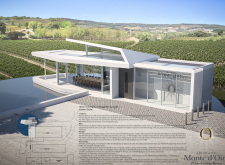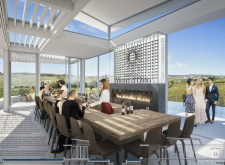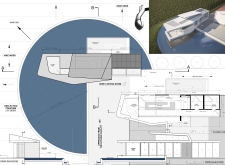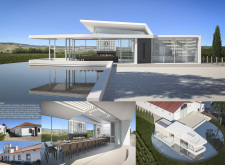5 key facts about this project
The primary function of this project is to provide a venue for wine tastings, allowing up to 30 guests to experience local wines in a setting that reflects the cultural essence of the vineyard. The building is strategically designed to facilitate both intimate gatherings and larger community events, with a layout that encourages interaction among visitors.
Architectural Layout and Key Elements
The architectural layout emphasizes both functionality and aesthetic appeal, with a linear configuration that connects various spaces seamlessly. The main wine tasting room is the centerpiece, featuring a communal table made from locally sourced timber. This element encourages shared experiences, aligning with the project's social objectives.
A significant aspect of the design is the reflection fountain, which lies adjacent to the tasting room. This feature serves not only as a visual focal point but also enhances the ambiance of the space, creating a tranquil environment conducive to wine appreciation. The outdoor patio extends the tasting experience, allowing guests to enjoy the vineyard view while immersed in nature.
Material Selection and Design Considerations
The project emphasizes sustainability through a conscious selection of materials. Locally sourced limestone forms the primary structural element for both exterior and interior walls, maintaining a connection to the region's architectural heritage. Smooth-polished plaster is utilized for interior finishes, contributing to a refined aesthetic that integrates with the natural setting. Large glass panels provide panoramic views, fostering a strong connection between the interior space and the vineyard.
Moreover, the building is designed to maximize natural light and ventilation. The orientation of the structure was carefully considered to optimize energy efficiency and indoor comfort. Horizontal strips acting as sunshades are incorporated into the design, reflecting the patterns found within vineyard rows. These unique design elements distinguish the Quinta do Monte d'Oiro Wine Tasting Room from conventional wine tasting facilities by creating a balanced relationship between architecture and nature.
Innovative Integration with Landscape
The relationship between the architectural design and the surrounding landscape is a pivotal feature of this project. The seamless integration of the building within the vineyard is achieved through thoughtful landscaping and strategic site planning. The outdoor spaces are designed to complement the architecture, encouraging movement between indoor and outdoor areas. This connection not only reflects the site's natural beauty but also enhances the visitor experience by allowing guests to engage with their surroundings actively.
The Quinta do Monte d'Oiro Wine Tasting Room exemplifies a thoughtful approach to architectural design, focusing on sustainability, community engagement, and environmental integration. For a deeper understanding of the project, consider exploring the architectural plans, sections, and design concepts that detail the innovative approaches taken. Engaging with these elements will provide further insight into the architectural intentions that shape this wine tasting facility.


























